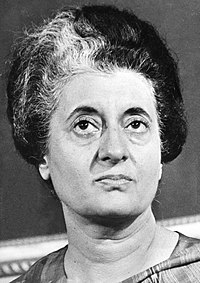
Photo from wikipedia
On June 25, 1975, Prime Minister (PM) Indira Gandhi imposed a national emergency (the Emergency) in India, suspending civil and political rights. Lasting for 21 months, the Emergency was the… Click to show full abstract
On June 25, 1975, Prime Minister (PM) Indira Gandhi imposed a national emergency (the Emergency) in India, suspending civil and political rights. Lasting for 21 months, the Emergency was the only dictatorial turn in India's democratic history. The authoritarian rule was in response to an assertive citizens' protest against Prime Minister Gandhi, which demanded her resignation on the grounds of the centralization of power, corruption, rising prices, and in the name of fair wages for workers and unemployment. The higher courts had also debarred her from contesting elections. Since then, the dominant accounts of this period have tried to ascertain answers to three questions: Why was the Emergency imposed? What did the Emergency entail? And finally, why was it lifted? The books in this review essay together comprise a tour de force on these three aspects, while also seeking to go beyond these questions. Christophe Ja relot and Pratinav Anil's India's First Dictatorship: The Emergency, 1975–77 shows how the Emergency has cast a long shadow and is also a window into understanding some of the present trends in Indian politics. Gyan Prakash's Emergency Chronicles: Indira Gandhi and Democracy's Turning Point claims that the Emergency had both a "before" and "afterlife"; the origins of excessive state power are inherent in the Constitution. Parsa Venkateshwar Rao Jr.'s The Emergency: An Unpopular History provides a revisionist account of the Emergency through the lenses of parliamentary discussions. While engaging with these important books, this review essay suggests an alternate "afterlife" of the Emergency that is untreated in the works discussed here.
Journal Title: Pacific Affairs
Year Published: 2023
Link to full text (if available)
Share on Social Media: Sign Up to like & get
recommendations!